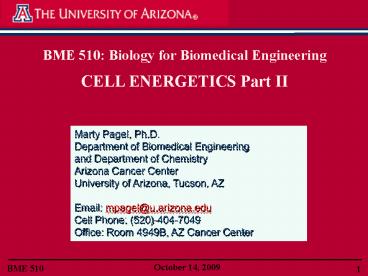Amino Acid Structure - PowerPoint PPT Presentation
1 / 10
Title:
Amino Acid Structure
Description:
Ketone body formation (ketogenesis) in liver mitochondria from excess acetyl CoA ... in mitochondria; reverse of ketogenesis. KETONE BODY OXIDATION ... – PowerPoint PPT presentation
Number of Views:97
Avg rating:3.0/5.0
Title: Amino Acid Structure
1
BME 510 Biology for Biomedical Engineering CELL
ENERGETICS Part II
Marty Pagel, Ph.D.Department of Biomedical
Engineering and Department of Chemistry Arizona
Cancer Center University of Arizona, Tucson,
AZ Email mpagel_at_u.arizona.edu Cell Phone
(520)-404-7049 Office Room 4949B, AZ Cancer
Center
2
FAT FACTS
- fat (lipid) makes up 37 of the calories in the
American diet - energy rich and provides 9 kcal/gm
- dietary lipids 90 triacylglycerols (TAGs) also
include cholesterol esters, phospholipids,
essential unsaturated fatty acids fat-soluble
vitamins - most dietary fat transported to adipose for
storage - dietary TAGs hydrolyzed in the intestine by
pancreatic lipases, then reassembled in the
intestinal cells - dietary fats transported to tissues as TAG or
cholesterol via chylomicrons - at peripheral tissues (e.g., adipose or muscle),
FA removed from the TAG by a lipoprotein lipase
in the capillary walls released fatty acids
diffuse into the cell
VLDL Very Low Density Lipoprotein LDL Low
Density Lipoprotein HDL High Density Lipoprotein
protein
choleterol
phospholipid
triglyceride
Chlyomicron
VLDL
LDL
HDL
3
LDL Particle Size and Apolipoprotein B Predict
Ischemic Heart Disease Quebec Cardiovascular
Study
6.2
(plt0.001)
Apo B
2.0
gt120 mg/dl
1.0
1.0
lt120 mg/dl
gt25.64
lt25.64
LDL Peak Particle Diameter (nm)
Lamarche B et al. Circulation 19979569-75.
4
Lypolysis of fatty acids and triacylglycerol
- fatty acids hydrolytically cleaved from
triacylglycerol - largely in adipose to release fatty acids as a
fuel - may also occur in muscle or liver - smaller
amounts of fatty acids are stored - hormone-sensitive (cyclic AMP-regulated) lipase
initiates lipolysis cleaves first
fatty acid - this lipase and others remove remaining fatty
acids - fatty acids/glycerol released from adipose to
the blood - hydrophobic fatty acids bind to albumin, in the
blood, for transport
saturated fatty acid CH3-(CH2)n-COOH unsaturat
ed fatty acid CH3-CHCH-(CH2)n-COOH polyunsatu
rated fatty acid CH3-CHCH-CH2-CHCH-(CH2)n-COOH
?
CH2----OOC-R1 CH2OH
HOOC-R1 ?
R2-COO----CH CHOH
HOOC-R2 ?
CH2----OOC-R3 CH2OH
HOOC-R3
Lipolysis
5
Fatty Acid Degradation
CAPILLARY
CYTOPLASM
FA fatty acid
cell membrane
LPL lipoprotein lipase
FABP fatty acid binding protein
ACS acyl CoA synthetase
6
TRANSPORT
palmitate a 16 carbon saturated fatty acid
Cytoplasm
OUTER MITOCHONDRIAL MEMBRANE
(step 4)
ACS
1
Intermembrane Space
palmitoyl-CoA
carnitine-acylcarnitine translocase (CAT) (step
5).
INNER MITOCHONDRIAL MEMBRANE
palmitoyl-carnitine
carnitine
Matrix
CoA
palmitoyl-CoA
7
inner mitochondrial membrane
Carnitine translocase
matrix side
2 ATP
3 ATP
palmitate a 16 carbon saturated fatty acid
Processing and ß-oxidation of palmitoyl CoA
Last cycle produces two Acetyl CoAs for
even-chain fatty acids
8
OXIDATION OF ODD-CHAIN FATTY ACIDS
Final step of ß-oxidation produces propionyl CoA
acetyl CoA
propionyl CoA carboxylase (biotin-dependent) prop
ionyl CoA ATP CO2 ? methylmalonyl CoA
AMP PPi
methylmalonyl CoA mutase (adenosyl
cobalamin-dependent) methylmalonyl CoA ?
succinyl CoA Therefore, 1 ATP is used and no
additional Acetyl-CoA molecules are produced
9
(excess acetyl CoA)
MITOCHONDRION
Ketone body formation (ketogenesis) in liver
mitochondria from excess acetyl CoA derived from
the ß-oxidation of fatty acids
10
KETONE BODY OXIDATION
- high rates of lipolysis (e.g., long-term
starvation or in uncontrolled diabetes) produce
sufficient ketones in the blood to be effective
as a fuel - ketones are the preferred fuel if glucose,
ketones, fatty acids are each available in the
blood - primary tissues using ketones, when available,
are brain, muscle, kidney and intestine, but NOT
the liver. - ß-Hydroxybutyrate NAD ß acetoacetate NADH
- ß-hydroxybutyrate dehydrogenase in mitochondria
reverse of ketogenesis
KETOACIDOSIS Excessive build-up of ketone bodies
results in ketosis eventually leading to a fall
in blood pH due to the acidic ketone bodies.
In diabetic patients, deficiency of insulin
causes mobilization and delivery of free fatty
acids to the liver. The liver oxidizes the fatty
acids to produce ketone bodies.































